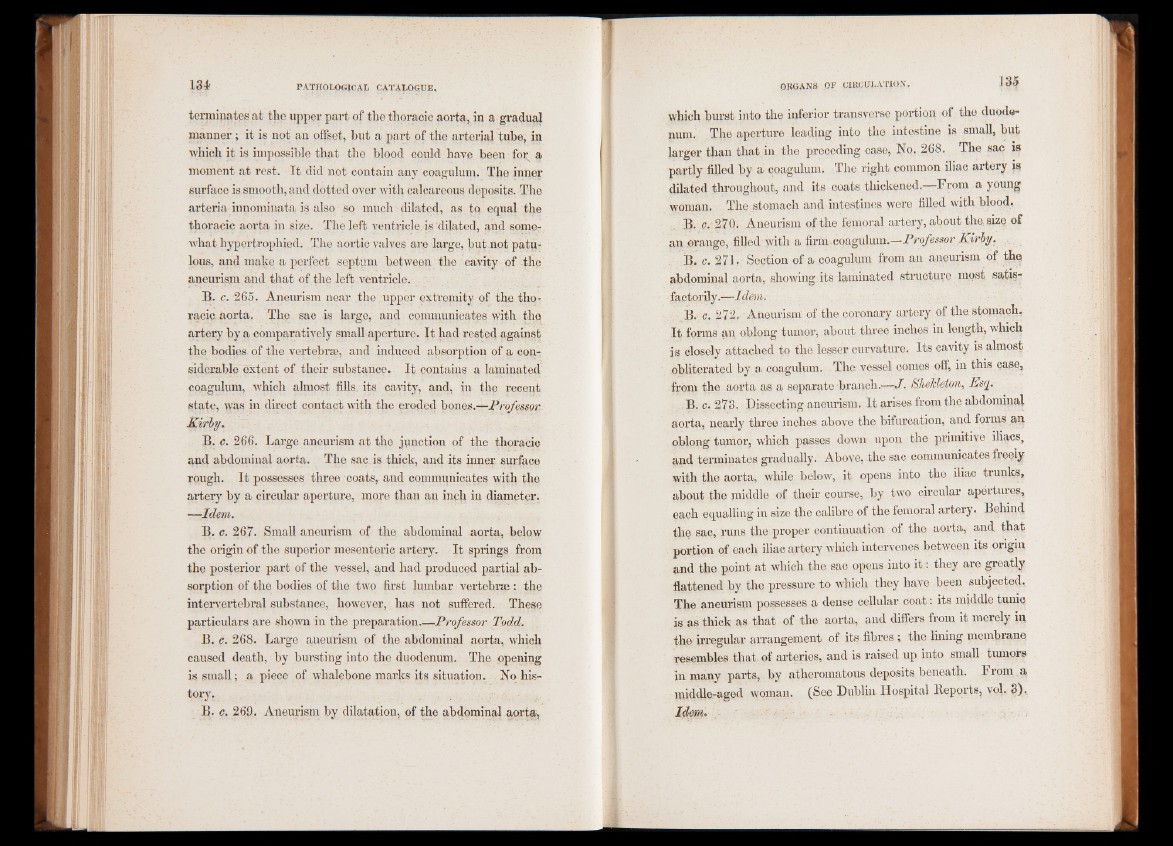
terminates at the upper part of the thoracic aorta, in a gradual
manner; it is not an offset, but a part of the arterial tube, in
which it is impossible that the blood could have been for a
moment at rest. It did not contain any coagulum. The inner
surface is. smooth, and dotted over with calcareous deposits. The
arteria innominata is also so much dilated» as to equal the
thoracic aorta in size. The left ventricle, is dilated, and some-,
what hypertrophied. The aortic valves are large, but not patulous,
and make a perfect septum between the cavity of the
aneurism and that of the left ventricle.
B. c. 265. Aneurism near the upper extremity of the thoracic
aorta. The sac is large, and communicates with tho
artery by a comparatively small aperture. It had rested against
the bodies of the vertebrae, and induced absorption of a considerable
extent of. their substance. It contains a laminated
coagulum, which almost fills its cavity, and, in the recent
state, was in direct contact with the eroded bones.—-Professor
Kirby.
B. c. 266. Large aneurism at the junction of the thoracic
and abdominal aorta. The sac is thick, and its inner surface
rough. It possesses three coats, and communicates with the
artery by a circular aperture, more than an inch in diameter.
—Idem.
B. c. 267. Small aneurism of the abdominal aorta, below
the origin of the superior mesenteric artery. It springs from
the posterior part of the vessel, and had produced partial absorption
of the bodies of the two first lumbar vertebrae : the
intervertebral substance, however, has not suffered. These
particulars are shown in the preparation__Professor Todd.
B. c. 268. Large aneurism of the abdominal aorta, which
caused death, by bursting into the duodenum. The opening
is small; a piece of whalebone marks its situation. No history.
B- c. 269., Aneurism by dilatation, of the abdominal aorta,
which burst into the inferior transverse portion of the duodenum.
The aperture leading into the intestine is small, but
larger than that, in the preceding case, No. 268. The sac is
partly filled by a coagulum. The right common iliac artery is
dilated throughout, and its coats thickened.—From a young
woman. The stomach and intestines were filled with blood,
B. c. 270. Aneurism of the femoral artery, about the size of
an orange, filled with a firm coagulum.—Professor Kirby.
B. c. 271. Section of a coagulum from an aneurism of the
abdominal aorta, showing its laminated structure most, satisfactorily.—
Idem.
B. c. 272, Aneurism of the coronary artery of the stomach.
It forms an oblong tumor, about three inches in length, which
is closely attached to the lesser curvature. Its cavity is almost
obliterated by a. coagulum. The vessel comes off, in this case,
from the aorta as a separate branch.—J. BheJcleton, Esq.
B. c. 273. Dissecting aneurism. It arises from the abdominal
aorta, nearly three inches above the bifurcation, and forms an
oblong tumor, which passes down upon the primitive iliacs,
and terminates gradually. Above, the sac communicates freely
with the aorta, while below, it opens into the iliac trunks,
about the middle of their course, by two circular apertures,
each equalling in size the calibre of the femoral artery. Behind
the sac, runs the proper continuation of the aorta, and. that
portion of each iliac artery which intervenes between its origin
and the point at which the sac opens into it: they are greatly
flattened by the pressure to which they have been subjected.
The aneurism possesses a dense cellular coat: its middle tunic
is as thick as that of the aorta, and differs from it merely in
the irregular arrangement of its fibres ; the lining membrane,
resembles that, of arteries, and is raised up into small tumors
in many parts, by atheromatous deposits beneath. From a
middle-aged woman. (See Dublin Hospital Reports, vol. 3),
Idem. X\,